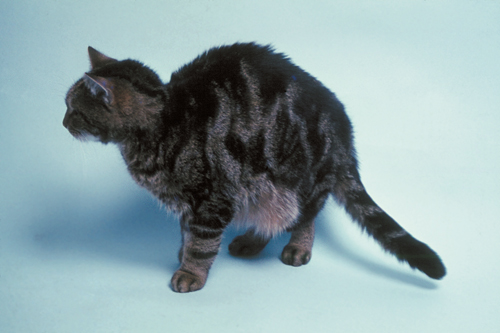Difference between revisions of "Feline Medicine Q&A 20"
(Created page with "{{Template:Manson Sparkes}} [[Image:|centre|500px]] <br /> '''A 6-year-old neutered male DSH presented with pitting oedema of the legs, ventral abdomen, and ventral thorax. Ra...") |
Ggaitskell (talk | contribs) |
||
| (One intermediate revision by one other user not shown) | |||
| Line 1: | Line 1: | ||
{{Template:Manson Sparkes}} | {{Template:Manson Sparkes}} | ||
| − | [[Image:|centre|500px]] | + | [[Image:Feline Medicine 20.jpg|centre|500px]] |
<br /> | <br /> | ||
| Line 20: | Line 20: | ||
|q2=How could this be confirmed and treated? | |q2=How could this be confirmed and treated? | ||
|a2= | |a2= | ||
| − | A PLN can be confirmed by evaluating urine protein loss with a UPC. In healthy cats the UPC is <0.5, and in cats with PLN it is typically >3 and may be >10. The UPC has to be interpreted with caution with lower urinary tract inflammation/bleeding. Renal biopsy could confirm immune-mediated glomerulonephritis. Treatment involves searching for and removing the inciting cause where possible (underlying infection, neoplasia, drug therapy). Many cases are idiopathic and require symptomatic therapy which is controversial. Diuretic use should be avoided. Protein supplementation is contraindicated, and glucocorticoids are generally unhelpful. Protein restriction is not valuable unless the disease has progressed to renal failure. ACE inhibitors (ramipril, enalapril, benazepril) have proven efficacy in canine glomerulonephritis, reducing proteinuria and improving clinical response, and are likely to be beneficial in cats also. Non-steroidal anti-inflammatories (e.g. aspirin) may help by reducing inflammation and any tendency for clotting due to anti-thrombin III loss. | + | A PLN can be confirmed by evaluating urine protein loss with a UPC. |
| + | |||
| + | In healthy cats the UPC is <0.5, and in cats with PLN it is typically >3 and may be >10. The UPC has to be interpreted with caution with lower urinary tract inflammation/bleeding. | ||
| + | |||
| + | Renal biopsy could confirm immune-mediated glomerulonephritis. | ||
| + | |||
| + | Treatment involves searching for and removing the inciting cause where possible (underlying infection, neoplasia, drug therapy). Many cases are idiopathic and require symptomatic therapy which is controversial. | ||
| + | |||
| + | Diuretic use should be avoided. Protein supplementation is contraindicated, and glucocorticoids are generally unhelpful. Protein restriction is not valuable unless the disease has progressed to renal failure. | ||
| + | |||
| + | ACE inhibitors (ramipril, enalapril, benazepril) have proven efficacy in canine glomerulonephritis, reducing proteinuria and improving clinical response, and are likely to be beneficial in cats also. | ||
| + | |||
| + | Non-steroidal anti-inflammatories (e.g. aspirin) may help by reducing inflammation and any tendency for clotting due to anti-thrombin III loss. | ||
|l2=Glomerulonephritis | |l2=Glomerulonephritis | ||
</FlashCard> | </FlashCard> | ||
Latest revision as of 11:44, 25 August 2011
| This question was provided by Manson Publishing as part of the OVAL Project. See more Feline Medicine questions |
A 6-year-old neutered male DSH presented with pitting oedema of the legs, ventral abdomen, and ventral thorax. Radiography revealed a mild thoracic and abdominal effusion. Some ascitic fluid was collected and analysis revealed a total protein of 1.5 g/l (0.15 g/dl).
| Question | Answer | Article | |
| What are the possible differential diagnoses for this cat and what is the primary differential diagnosis? | The presence of both oedema and effusions could be due to congestive heart failure but is more likely to be due to hypoalbuminaemia. The presence of a pure transudate in the abdomen confirms the cause to be hypoalbuminaemia, and serum albumin is usually <15 g/l (<1.5 g/dl) for this to occur. Major causes of hypoalbuminaemia are:
|
Link to Article | |
| How could this be confirmed and treated? | A PLN can be confirmed by evaluating urine protein loss with a UPC. In healthy cats the UPC is <0.5, and in cats with PLN it is typically >3 and may be >10. The UPC has to be interpreted with caution with lower urinary tract inflammation/bleeding. Renal biopsy could confirm immune-mediated glomerulonephritis. Treatment involves searching for and removing the inciting cause where possible (underlying infection, neoplasia, drug therapy). Many cases are idiopathic and require symptomatic therapy which is controversial. Diuretic use should be avoided. Protein supplementation is contraindicated, and glucocorticoids are generally unhelpful. Protein restriction is not valuable unless the disease has progressed to renal failure. ACE inhibitors (ramipril, enalapril, benazepril) have proven efficacy in canine glomerulonephritis, reducing proteinuria and improving clinical response, and are likely to be beneficial in cats also. Non-steroidal anti-inflammatories (e.g. aspirin) may help by reducing inflammation and any tendency for clotting due to anti-thrombin III loss. |
Link to Article | |
